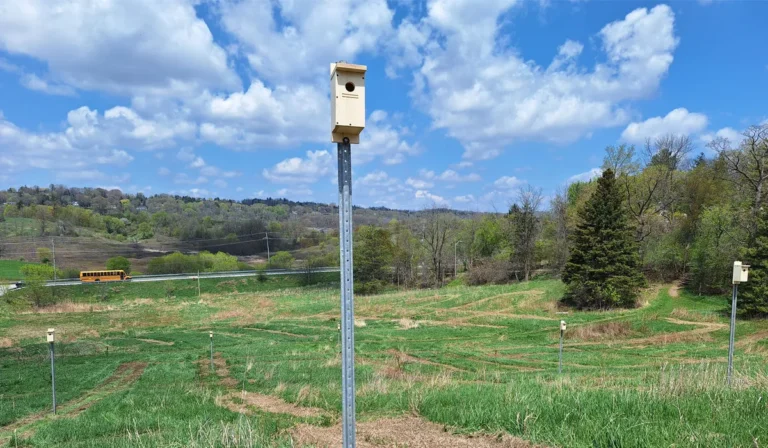Oak Wilt is a new invasive threat to Oak trees in Ontario, but what is it? Why is it a problem? Where did it come from? And how can it be identified and managed? Learn all about Oak Wilt here.
What is Oak Wilt?
Oak Wilt is an invasive pathogen or disease that infects the vascular layer of the tree beneath the bark. The fungus responsible for Oak wilt, Bretziella fagacearum, has recently been detected in Ontario.
Why is it a problem?
Oak Wilt can cause a mature oak tree to experience a full leaf drop within a few weeks from infection – going from full and green in the spring to completely bare by August. Red oaks are most susceptible to Oak Wilt and can die just one year after infection. This high mortality rate has huge implications, including food and habitat loss and reduced tree canopy, both in urban and natural settings. It’s also very expensive to remove dead oaks.
Where did it come from?
Oak wilt was first detected in 1944 in the United States, but its exact origin is unknown. Some theories link it to previously undiscovered fungi in the eastern U.S., as well as an exotic threat arriving sometime in the 1900s. This past year, cases of Oak Wilt were discovered in Niagara Falls, Niagara-on-the-Lake, and Springwater. It likely came to Ontario through the transport of timber, lumber, or firewood.
How to identify at various stages
Oak Wilt affects all oaks but is most common and damaging to Red oaks. White oaks have moderate resistance to the disease, see lower rates of infection, and may take much longer to die. Since there are many other types of threats that can create sickness in oak trees, like Oak Anthracnose, Oak Blight, and Oak Leaf Blister, you should look for the following signs of Oak Wilt:
- Leaves
- Oak Wilt gets its name from the appearance of the leaves of an infected tree. Leaves will become off-green or brown in colour. Discolouration will start at the crown (top) of the tree and spread downwards, producing dropping brown, wilted leaves after a few weeks. The discolouration of leaves will begin at the margins (edges) of the leaves before spreading towards the veins and stems. Leaves that turn brown uniformly or show discolouration throughout the tree at the beginning of an infection are likely suffering from a different ailment.
- Dying trees
- Trees that begin to die from Oak Wilt will appear bare, with no or very few leaves when they should have full leaf out. If the tree does not attempt to grow new buds or leaves by the summer, there’s a good chance it’s is dying. The bark may also begin to show vertical cracks later in the year after infection. Slight discolouration of the branches may be present, but it can be difficult to tell.
- Dead tree
- Trees that have died from Oak Wilt will have a telltale feature of pressure pads the year following the infection. Pressure pads are fungal masses that grow under the bark in the fall and winter after infection and push up on the bark to create cracks and openings to allow the spores to spread. They are dark in colour and may have a sweet smell. Wood cut from a dead tree will also show vascular streaking when the cross-section of a branch will have a dark ring near the outer edge of the woody material.
Transmission
Oak Wilt spreads in two ways:
- Above Ground: Insects called sap beetles or picnic beetles, feed on the sweet-smelling pressure pads. Like a bee picking up pollen, the beetles pick up spores produced by the fungal mats, and bring spores to new trees. Nitidulid beetles are a type of wood-boring beetle, and by entering wounds on previously uninfected trees with those spores, Oak Wilt can continue to spread.
- Below ground: Infected tree roots can transmit the disease by coming into contact with the roots of healthy oaks. The process is called root grafting. The Oak Wilt fungus can live for many seasons after the above ground portion of the tree has died, allowing for transmission to continue.
How to control and manage
Landowners can take several clear strategies to support oak trees and prevent spread. Oak Wilt is a slow-moving pathogen, making management more feasible when compared to other invasive threats such as the Emerald Ash Borer. To prevent Oak Wilt:
- Do not prune oak trees between April and October. This is when beetles are most likely to be entering fresh wounds and potentially spreading spores
- Watch for sick oaks in your neighborhood, and inform others of the risk of oak wilt
- Never move firewood
- Should you find a tree you think may be afflicted, contact the Canadian Food Inspection Agency at OakWiltReportingOntario-Fletrissementduchene@inspection.gc.ca
Additional Resources
- https://www.invasivespeciescentre.ca/invasive-species/meet-the-species/invasive-pathogens/oak-wilt/
- https://extapps.dec.ny.gov/docs/lands_forests_pdf/oakwiltusda.pdf
- https://inspection.canada.ca/plant-health/invasive-species/plant-diseases/oak-wilt/eng/1325624048625/1325624535106
Photo source
https://nyis.info/invasive_species/oak-wilt/









